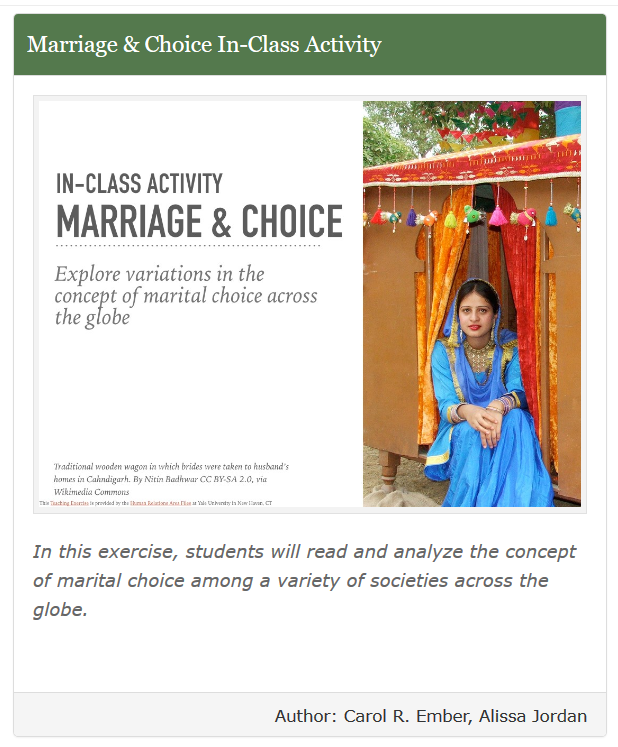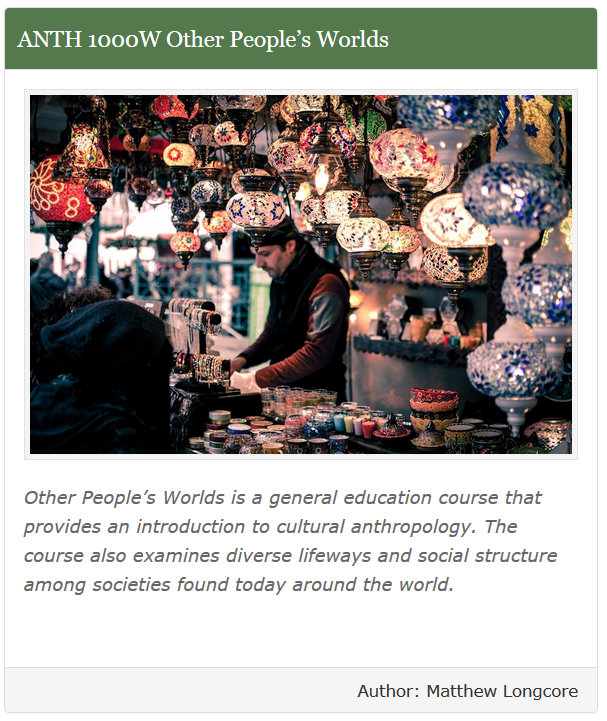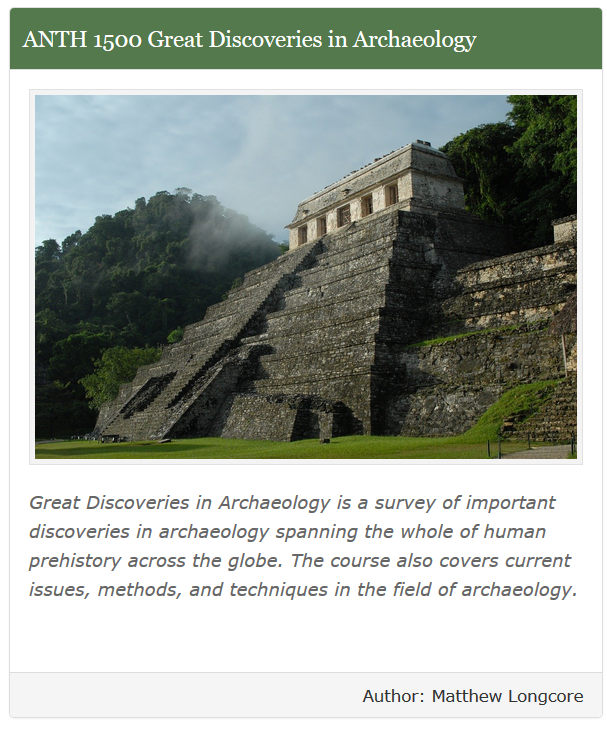
This is a 3-part series. Go to Part 2: Teaching eHRAF: In-Class Activities for online learning
Go to Part 3: Remote futures: tips for online teaching and learning in anthropology
Page Contents
In the wake of the COVID-19 outbreak and pandemic, academic departments, faculty, and students alike are endeavoring to adjust to a new reality of teaching and learning remotely due to university campus closures, self-isolation, and international lock-down conditions. Physical and mental health and well-being have more than ever become the priority for all involved. Yet maintaining connectivity between faculty and students while continuing the education process is also an important factor in keeping our academic communities safe, healthy, and engaged throughout these difficult times.
Present circumstances have created unforeseen anxieties and tensions across many facets of daily life. With the vast majority of students and faculty currently telecommuting to class, we continue to see a dramatic shift to conducting and attending classes wholly online. Classrooms have been exchanged for living rooms; or, often, for whatever corner of the home and fraction of the day are available for study or teaching preparation. While online teaching is certainly nothing new, it is definitely a daunting experience for many participants on both sides of the screen. The “pivot to online” therefore presents a challenge that is best met by working together.
Now is a time for the global academic community to come together on behalf of our colleagues, students, friends, and strangers who are up against unprecedented adjustments to their daily lives. Digital collaborations require many helping hands to keep education moving forward. The Twitter hashtag #CovidCampus is one such example. Resuming academic life in this new format while approximating as much “normalcy” and continuity as we can muster is just one small step towards easing the burdens that many of us are facing – especially those for whom the campus, classroom, and library were a safe haven, and colleagues and classmates an essential support system.
Online teaching and learning resources from HRAF
Leveraging digital learning tools efficiently and responsibly is, in the short term, a priority for moving forward. HRAF remains committed to the continued development of our databases and open access resources throughout this trying time, and would like to share what teaching and learning materials we have available, as well as to offer suggestions for incorporating them into remote classrooms while transitioning to online learning.
As a longtime provider of online anthropological databases – eHRAF World Cultures and eHRAF Archaeology – HRAF would like to assist our members as well as other anthropology instructors, researchers, and students in making the most of our products. This post will explain how to ensure that access to eHRAF remains uninterrupted during campus closures. It will also offer some tips for using eHRAF for remote learning, such as how to obtain a free extended trial for your institution.
Next, we’ll explore our free and open access databases and resources that can be used alone or alongside the eHRAF Databases, including Teaching eHRAF (a repository of sample teaching syllabi); Explaining Human Culture (a database summarizing cross-cultural research findings from over 1000 studies); Introducing Cross-Cultural Research (a PDF-based guided-learning course); and our homepage. Visit our Products page to learn more about each of the databases and open access resources described below.
eHRAF World Cultures and eHRAF Archaeology
HRAF has over 550 member institutions throughout the world. Visit this page to see if your institution already has access to eHRAF. You may be familiar with our flagship eHRAF Databases from your campus library or existing classroom assignments. But did you know that members (or institutions on a free trial) can access eHRAF for remote learning from off-campus just as easily?
Comprising the largest anthropological databank in the world, our ethnographic and archaeological databases include over 880,000 pages of expertly indexed information on over 420 cultures and traditions. Having hundreds of pages of ethnographic and archaeological material at your fingertips can be an invaluable resource when working remotely without access to a physical library or field location, especially for the preparation of classroom or homework materials.The databases contain many original anthropological and archaeological texts including classic ethnographies from authors such as Malinowski, Mead, Evans-Pritchard, and Boas – to name just a few – that you might otherwise find on a library shelf (and some that you might not).
Unlike static academic file repositories of articles in PDF format, eHRAF allows users to search through the entire database at once, and to zoom in on relevant passages across all of the documents in our collections in moments. Each and every paragraph has been subject-indexed by anthropologists at HRAF with OCM identifiers in the sidebar so that readers can easily see which topics of interests are covered, and then follow those subject identifiers throughout the database to find additional ethnographic texts on the same and related topics across cultures. This enables rapid retrieval across hundreds of thousands of pages of text. Results are presented initially at the paragraph level with the option to jump out to the original document page for more context and to dig deeper into the source ethnography or archaeological data. It is also possible to browse for specific topics or cultures, and to narrow searches by region, subsistence type, and samples.
Adjusting to remote teaching with eHRAF
Update 04/30/2020: Looking for online anthropology teaching materials? Our eHRAF Workbooks are a great place to start.
eHRAF offers added benefits for instructors pivoting their traditional offline classroom instruction to one or more digital environments. For example, the presentation of results paragraph by paragraph (or page by page) could be considered tailored to flexible learning needs. Both instructors and students working in less-than-ideal remote conditions away from their usual campus settings will undoubtedly be dealing with additional pressures on their time. Traditional assignments of lengthy readings may need to be truncated to fit this modified method of learning. eHRAF’s focus on parts of the whole can help achieve this without sacrificing the quality of ethnographic narratives from anthropological sources.
Juggling upheavals at home with academic tasks, students will – perhaps more than ever – need guidance to take on reading and coursework in manageable bites without losing the benefit of rich anthropological data. In absence of the physical campus locations in which to orientate their studies, students will be especially reliant on their remote faculty to guide them. Thus, one advantage to HRAF’s paragraph-level indexing is the ease of assigning specific passages or small sections of particular ethnographies.
Utilizing both browse and search capabilities, instructors can design tasks or quizzes based on eHRAF content, or assign more open-ended exploratory exercises that let students use eHRAF as a discovery engine to learn more about global cultures at their own speed. Of course, one of eHRAF’s most notable applications is for comparative research. Students can find information about one or more topics – such as gender, marriage, or social status – across hundreds of societies at once, in order to compare and contrast ethnographic accounts from around the world. Yet it is also ideal for studying individual cultures in depth, one at a time.
To illustrate, the following is a brief example of an eHRAF class assignment question on the subject of witchcraft as a belief system:
To answer, read the passage about an old granary collapsing on pages 69-70 of Witchcraft, Oracles and Magic Among the Azande (1937) by Evans-Pritchard.
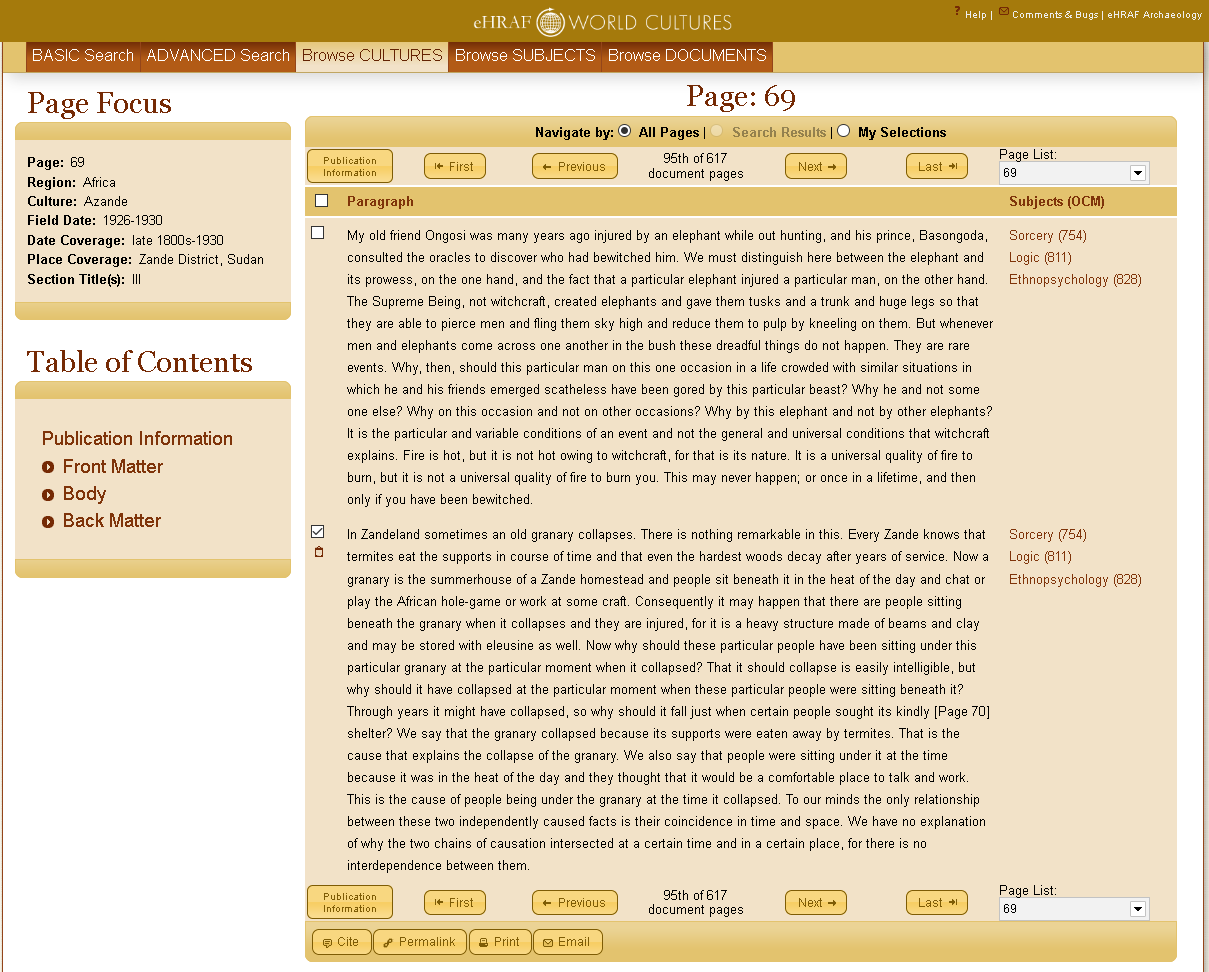
Page results for Evans-Pritchard (1937) Witchcraft, Oracles and Magic Among the Azande (p. 69), in eHRAF World Cultures
Introductory students can be asked to think about how this passage compares with their own cultural understanding of the concepts of coincidence or good and back luck. For more advanced classes, the assignment could be expanded to have the students conduct additional research in eHRAF to find comparative examples of chance, misfortune, magic and witchcraft in other societies.
Additionally, students can also be asked read more articles or books by the same author in eHRAF (by browsing documents for Evans-Pritchard), or other texts from within the same culture collection, all on the same platform. Use permalinks and citations to direct students to documents and reference sources in eHRAF.
Coursework in eHRAF can be done as an independent research project (asynchronously) prior to any online “class hours”, and students can prepare talking points to then discuss during any synchronous group discussion or online seminars. Alternatively, students can discuss their findings with others in a synchronous or asynchronous text-based online forum. A future post will present these and other online learning tips for transitioning to remote classes.
eHRAF World Cultures is ideal for approaching anthropological questions like, “How does division of labor by gender vary across cultures?” or “What kind of belief systems are common among hunter-gatherers?” And so on. The worldwide scope gives plenty of material to draw from, and eHRAF Archaeology covers prehistoric traditions. In addition to rich ethnographic and archaeological data, each culture or tradition in eHRAF has an extensive summary written by a HRAF anthropologist. Even without HRAF membership, it is possible to access our Culture Summaries and use these to supplement classroom teaching.
? Tip for instructors: Whether your library is an existing member of HRAF, or you decide to sign up for one of our trials, be sure to inform your students how they can go about accessing your library’s digital resources from off-campus well ahead of receiving their assignments.
Membership and free trials

For instructors: To obtain access to eHRAF World Cultures or eHRAF Archaeology for yourself or your class, first check to see if your university is a member by searching the tables on this page.
If your university or college is already a member of HRAF, your students will have access to the databases in their entirety via their usual university ID/library login, even from off campus. Please be sure to make your students aware of your library’s process for accessing resources off campus, for example via the library website portal or by using a VPN. Each institution’s procedure can vary slightly.
If your institution is not yet a member, we offer free 60-day trials. At the time of writing, this should see you through to the end of the Spring 2020 term and give you and your institution time to evaluate long-term membership for the summer or fall semesters. Trials require IP addresses to be provided to HRAF by your institution’s library. Given present circumstances surrounding COVID-19, HRAF may be able to extend your trial free of charge beyond the initial 60 days. We will be in touch as the situation continues to unfold and your trial nears completion. Sign up here for an institutional trial.
Alternatively, if you wish to use eHRAF only for research or teaching preparation and not large-scale student activity, a free individual 30-day trial for instructors is available. Again, due to present circumstances, HRAF will be extending the length of our free individual trials through to the end of the academic year. Sign up here for an individual trial.
Note that for virtual classroom use via remote learning, it still benefits your institution to sign up for an institution-wide trial. It makes signing in to the databases more seamless for students, and provides your home institution with usage statistics that enable them to make better informed decisions about future resource allocation. However, if you find that your university library is closed or inaccessible and administrators are unable to process requests for trials, please use the individual trial link above to receive a password for personal use.
 Teaching eHRAF
Teaching eHRAF
If you’re looking for ideas on how to incorporate exercises using the eHRAF databases into your new or newly online courses, Teaching eHRAF is our open-access repository of sample syllabi and teaching materials. We have nearly 60 exercises available thus far and are in the process of adding new exercises specifically designed for introductory courses and remote learning environments over the coming weeks and months.
In Teaching eHRAF, you can search and browse for topics of interest and use the existing syllabi as-is, or simply refer to them as a guide to modify the relevant portions to better suit your own classes. Some of the exercises include easy-to-share PDFs, PowerPoints or other media, including those marked In-Class Activity. There are different assignment types (such as quizzes, short papers, or group projects), and a wide range of anthropological subjects covered under four main headers: General Anthropology, General Archaeology, Medical Anthropology, and Research Methods. You can learn more about the contents of Teaching eHRAF here.
Here is a small selection of the syllabi available in Teaching eHRAF:
All of the exercises in Teaching eHRAF make use of the eHRAF databases in some way, and are therefore best utilized with a full membership, so we encourage instructors to sign up for a trial if your institution is not yet a member (see above for more information). That said, the repository itself is open access, so the exercises are free to browse online without membership.
As always, we welcome contributions of similar sample syllabi and classroom activities featuring the eHRAF databases. For instructors using eHRAF to teach about epidemics during the COVID-19 pandemic, please get in touch so we can include your syllabi as soon as possible. Feel free to also get in touch should you need assistance adapting any of the exercises for remote teaching needs.
? If you would like personalized help incorporating eHRAF into your research or teaching curriculum, contact us about a webinar.
Explaining Human Culture
Explaining Human Culture (EHC), is a publicly accessible database containing information on over 1,000 cross-cultural studies spanning more than 100 years. In EHC, we provide a searchable way for researchers to find out what we have learned from previous cross-cultural research about cultural universals and differences. We do this by summarizing the purpose of each study, the hypotheses tested, whether the hypotheses are supported, the variables, and the subject-categories in eHRAF World Cultures that may apply to these variables.
EHC also contains topical summaries of what has been learned from cross-cultural research, or more precisely, what we think we know, and to point out some of the things that we do not yet know. These summaries are a great place to begin thinking about cultural universals and synthesizing broad anthropological questions and findings across societies, making them ideal for classroom use, to initiate group discussion, or as supplementary online reading. Here are the summaries that are currently available:
Each of the topical summaries in EHC also contains a companion teaching exercise for instructors that can be found in Teaching eHRAF. Refer to the section “Exercises Using eHRAF World Cultures” in each of the aforementioned modules to find the supplementary teaching materials.
As we continue to grow Explaining Human Culture, we will also be developing additional video guides and tutorials to assist users in making the most of this open-access resource. Two videos coming soon are: “How to use EHC (Getting Started)” and “How to use EHC in conjunction with Teaching eHRAF”. New videos are posted to our homepage, social media and YouTube channels. Be sure to sign up for our monthly newsletter to get updates on EHC and all of our resources straight to your inbox.
Introducing Cross-Cultural Research
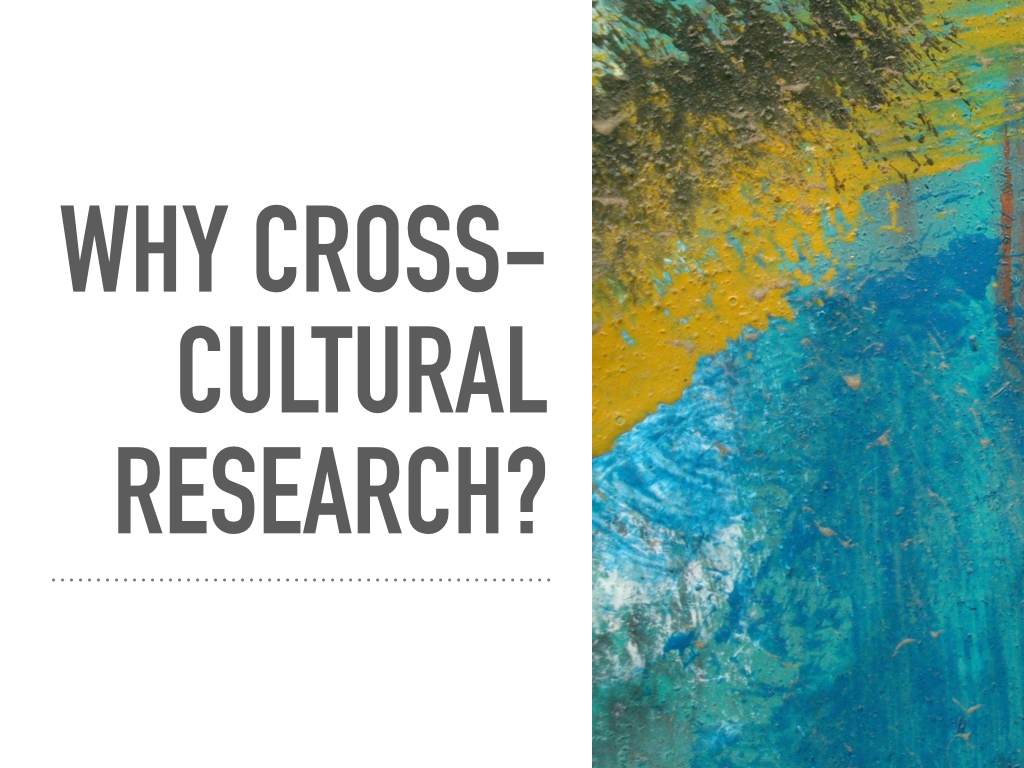
Introducing Cross-Cultural Research is HRAF’s visual online course on the fundamentals of cross-cultural research. Like Teaching eHRAF and EHC, it is freely accessible and open access. The course, presented over 8 chapters in colorful and inviting PDFs, makes an excellent online learning companion to our other cross-cultural resources described above. It can be used on its own, or assigned as guided independent reading to introduce students and beginners to cross-cultural methods. The chapters cover the logic of cross-cultural research, framing a research question, deriving hypotheses from theory, design of measures, coding procedures, sampling, reliability, and the use of statistics to analyze results.
In addition, HRAF’s more text-based Basic Guide to Cross-Cultural Research is also available on our home page.
eHRAF Highlights and HRAF Homepage

Alongside our suite of products detailed throughout this post, another place to find fun and engaging content for the virtual classroom is our homepage. Many of the posts in our eHRAF Highlights blog present snippets of cultural life from around the world, accessibly written, and illustrated with rich ethnographic or archaeological examples from eHRAF World Cultures and Archaeology. Instructors consistently find these posts useful for generating lively discussion on timely and thought-provoking anthropological themes and cultural comparisons, from holidays like St. Patrick’s Day or Halloween to foods like cheese and chocolate, or topics like body positivity and romantic kissing. Each post is fully referenced, can be adapted in conjunction with other coursework material, accessed on any platform, and easily shared.
Learn more
This post has summarized how each of HRAF’s digital products can offer benefits for students, researchers and instructors adjusting to remote teaching and learning environments as a result of university closures due to the COVID-19 pandemic. While many of our resources are entirely open-access, HRAF member institutions benefit from being able to use them in conjunction with HRAF’s other products – namely the eHRAF World Cultures and eHRAF Archaeology databases. We encourage you to request a free 60-day institutional trial through your university if your library administration is still available to procure resources at this time. This will enable full classes to have unrestricted off-campus access to eHRAF. Alternatively, we are happy to extend individual password trials for teachers, students, or researchers working independently.
In order to assist educators in adapting to remote teaching conditions, we will shortly be sharing an additional post containing more tips for adjusting to online teaching and learning. In the meantime, here are several other useful resources on our homepage:
Go to Part 2: Teaching eHRAF: In-Class Activities for online learning
Go to Part 3: Remote futures: tips for online teaching and learning in anthropology


